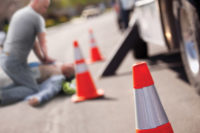How to find life-saving AEDs

Another app called iRescU, developed by a global interdisciplinary team of experts in emergency care, public health, media technology and interface design, combines this AED locating capability with AED/CPR training and support in an emergency situation. iRescu sponsors ongoing challenges in which participants take a photo of any AED anywhere in the world and upload the photo and AED type and location at www.iRescU.info/AEDupload.htm.
Similarly, the MyHeartMap Challenge, which took place early in 2012, was an initiative aimed at finding all AEDs in public places in the city of Philadelphia. The goal of the initiative was to create an AED map and a database for the 911 center, so operators will be able to direct callers to the nearest AED in the event of an out-of-hospital cardiac arrest. Over 300 people participated, identifying more than 1,500 AEDs in Philadelphia County.
More work to be done
Despite the commendable efforts of these groups, experts say there is still much work to be done.
“While reliable data are scant, of the estimated 225,000 reports each year of people collapsing of sudden cardiac arrest, some experts estimate AEDs are generally used to help fewer than 5% of victims,” according to a recent Wall Street Journal article.
Locating AEDs is only one critical piece of the puzzle, according to Richard Lazar, an AED program consultant.
“A variety of people are collecting the information,” says Lazar. “The problem is it can’t be made useful the way the system is currently designed because there’s no way to leverage that information in real life.”
Other issues include a limited number of devices in the community and limited access to those devices. Although public access to AEDs is greater than ever — about 1 million have been purchased in the U.S., with devices found in airports, shopping malls, health clubs, schools, office buildings and more — the probability that a sudden cardiac arrest victim will collapse near one of these devices is statistically low.
“We have very few AEDs relative to the amount of area that needs to be covered,” says Lazar. “I estimate that we have less than 1 percent coverage of the urbanized United States right now.”
And even if an AED is the vicinity of where an emergency occurs and bystanders know where the device is, there’s a good chance they will be unable to use it due to liability issues, says Lazar.
“Typically, there’s a restricted model in the deployment and use of AEDs. So if I buy an AED for my grocery store, my lawyers are going to tell me that I can’t let that AED go next door to the Hallmark card shop. It can’t leave the facility.”
The AED might not even be allowed to be taken outside to address an emergency in the parking lot, says Lazar. And within the same office building, an AED purchased by one business may not be able to be used in the offices of a different business.
911 to the rescue?
According to Lazar, 911 dispatch agencies are key to the utilization of AEDs.
“911 is truly the central point of contact for emergency response resources,” says Lazar. “We know people will call 911, and unless and until 911 dispatch agencies leverage that (AED) data, we’re not going to fully utilize the limited number of AEDs that are currently deployed.”
For this to happen, says Lazar, there needs to be a more formalized approach to collecting AED location data. Then the vast majority of 911 agencies (a huge number that he estimates at around 22,000 local jurisdictions in the U.S.) would have to be willing to incorporate AED location data into their dispatch systems and use it in the event of a sudden cardiac arrest. In addition, Lazar says that AED laws in this country will need to be improved so facilities that own AEDs will authorize use of the device off their property.
Looking for a reprint of this article?
From high-res PDFs to custom plaques, order your copy today!







